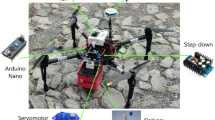Abstract
In this study, an obstacle avoidance algorithm, with variable range searching, is proposed for a mobile robot. In the case of the distance transform method, the mobile robot cannot avoid the obstacle when it is narrow. We prepare a grid map with the obstacle and distance levels from a destination. A path with both the least number of turns, and the shortest distance, is generated. The search range depends on the distance between the current position and the obstacle. The algorithm can generate the avoidance path without regard to the shape of the obstacle. In the computer simulation, the proposed algorithm can generate a path that avoids the obstacle. As an experiment, a position detection system used contrast differences, by means of a web camera, to get the coordinates of the mobile robot. It is confirmed that, in the experiment, the mobile robot reached the goal grids without hitting the obstacle.














Similar content being viewed by others
References
Roland S, Illah RN, Davide S (2004) Introduction to autonomous mobile robots. The MIT Press, New York
Padgett C, Kreutz-Delgado K (1997) A grid algorithm for autonomous star identification. IEEE Trans Aerosp Electron Syst 33(1):202–213
Weigl M, Siemiaatkowska B, Sikorski K, Borkowski A (1993) Grid-based mapping for autonomous mobile robot. Robot Auton Syst 11(1):13–21
Zelinsky A, Jarvis RA, Byrne JC, Yuta S (1993), Planning paths of complete coverage of an unstructured environment by a mobile robot. Proc Int Conf Adv Robot 13(9):533–538
Ohki T, Nagatani K, Yoshida K (2012) Local path planner for mobile robot in dynamic environment based on distance time transform method. Adv Robot 26:1623–1647
Gao C, Ohya A, Yuta S (2009) Obstacle avoidance algorithm for mobile robot running on the planned path. SI2009 SICE Syst Integr 304(3):2141–2144
Hosoda Y et al (2010) Collision-avoidance algorithm for human-symbiotic robot. In: ICCAS 2010, pp 557–561
Tian J, Gao M, Lu E, (2007), Dynamic collision avoidance path planning for mobile robot based on multi-sensor data fusion by support vector machine. In: 2007 international conference on mechatronics and automation, pp 2779–2783
Jang ES, Jung S, Hsia TC (2005) Collision avoidance of a mobile robot for moving obstacles based on impedance force control algorithm. In: 2005 IEEE/RSJ international conference on intelligent robots and systems, Edmonton, pp 382–387
Sphero 2.0 (2019) https://www.sphero.com/sphero-2-0. Accessed 2019
https://github.com/hybridgroup/sphero. Accessed 2019
Zelinsky A (1992) A mobile robot exploration algorithm. IEEE Trans Robot Autom 8(6):707–717
Author information
Authors and Affiliations
Corresponding author
Additional information
Publisher’s Note
Springer Nature remains neutral with regard to jurisdictional claims in published maps and institutional affiliations.
About this article
Cite this article
Natori, H., Tokuyama, K. & Mukai, M. Obstacle avoidance path generation method for mobile robot using varying search range. Artif Life Robotics 24, 285–290 (2019). https://doi.org/10.1007/s10015-019-00532-2
Received:
Accepted:
Published:
Issue Date:
DOI: https://doi.org/10.1007/s10015-019-00532-2




